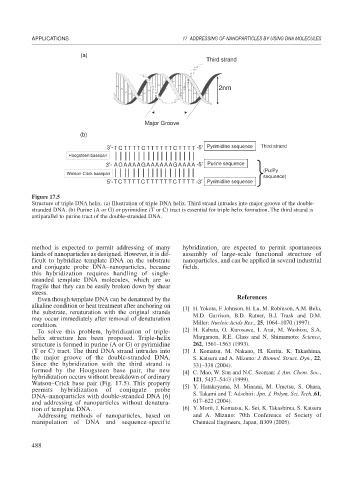Page 516 - Book Hosokawa Nanoparticle Technology Handbook
P. 516
APPLICATIONS 17 ADDRESSING OF NANOPARTICLES BY USING DNA MOLECULES
(a)
Third strand
2nm 2nm
Major Groove
(b)
3′- TC TTT C TTTT TT C TTT T -5′ Pyrimidine sequence Third strand
T
Hoogsteen basepair
A
3′- AGAAAAGAAAAAAGA A A -5′ Purine sequence
(Pu/Py
Watson-Crick basepair
sequence)
T
5′- TC TTT C TTTTTT C TTT T -3′ Pyrimidine sequence
Figure 17.5
Structure of triple DNA helix. (a) Illustration of triple DNA helix. Third strand intrudes into major groove of the double-
stranded DNA. (b) Purine (A or G) or pyrimidine (T or C) tract is essential for triple helix formation. The third strand is
antiparallel to purine tract of the double-stranded DNA.
method is expected to permit addressing of many hybridization, are expected to permit spontaneous
kinds of nanoparticles as designed. However, it is dif- assembly of large-scale functional structure of
ficult to hybridize template DNA on the substrate nanoparticles, and can be applied in several industrial
and conjugate probe DNA–nanoparticles, because fields.
this hybridization requires handling of single-
stranded template DNA molecules, which are so
fragile that they can be easily broken down by shear
stress.
Even though template DNA can be denatured by the References
alkaline condition or heat treatment after anchoring on [1] H. Yokota, F. Johnson, H. Lu, M. Robinson, A.M. Belu,
the substrate, renaturation with the original strands M.D. Garrison, B.D. Ratner, B.J. Trask and D.M.
may occur immediately after removal of denaturation
condition. Miller: Nucleic Acids Res., 25, 1064–1070 (1997).
To solve this problem, hybridization of triple- [2] H. Kabata, O. Kurosawa, I. Arai, M. Washizu, S.A.
helix structure has been proposed. Triple-helix Margarson, R.E. Glass and N. Shimamoto: Science,
structure is formed in purine (A or G) or pyrimidine 262, 1561–1563 (1993).
(T or C) tract. The third DNA strand intrudes into [3] J. Komatsu, M. Nakano, H. Kurita, K. Takashima,
the major groove of the double-stranded DNA. S. Katsura and A. Mizuno: J. Biomol. Struct. Dyn., 22,
Since the hybridization with the third strand is 331–338 (2004).
formed by the Hoogsteen base pair, the new [4] C. Mao, W. Sun and N.C. Seeman: J. Am. Chem. Soc.,
hybridization occurs without breakdown of ordinary 121, 5437–5443 (1999).
Watson–Crick base pair (Fig. 17.5). This property [5] Y. Hatakeyama, M. Minami, M. Umetsu, S. Ohara,
permits hybridization of conjugate probe
DNA–nanoparticles with double-stranded DNA [6] S. Takami and T. Adschiri: Jpn. J. Polym. Sci. Tech.,61,
and addressing of nanoparticles without denatura- 617–622 (2004).
tion of template DNA. [6] Y. Morii, J. Komatsu, K. Sei, K. Takashima, S. Katsura
Addressing methods of nanoparticles, based on and A. Mizuno: 70th Conference of Society of
manipulation of DNA and sequence-specific Chemical Engineers, Japan, B309 (2005).
488

